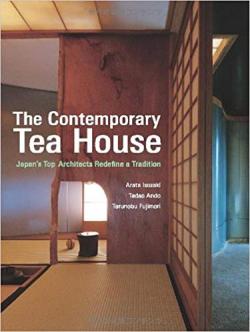The Contemporary Tea House: Japan's Top Architects Redefine a Tradition

By Arata Isozaki, Tadao Ando and Terunobu Fujimori
Kodansha International (2007)
ISBN 13: 9784770030467
Review by Sir Hugh Cortazzi
This addition to Kodansha's architectural series is likely to be of interest not only to students of architecture and the Japanese way of tea but also to a wider readership. Arata Isozaki and Tadao Ando are world famous architects. Terunobu Fujimori who is an architectural historian is a professor at the University of Tokyo.
Anyone interested in Japanese culture will be conscious of the role which traditional tea houses and the cult of tea have played in the history of Japanese civilization, but probably few are aware of the designs and building of tea houses by famous Japanese contemporary architects.
The book begins with a historical introduction by Professor Terunobu Fujimori on "The development of the tea room and its meaning in architecture." He explains how the first tea houses developed from the tea contests (tocha) in which samurai participants had to identify correctly the provenance of a particular tea. He describes the first tea houses which were termed iori (hermitages) where men escaped from the towns to the countryside for quiet contemplation. Their huts came to be about 3 metres square or 4.5 tatami (yojohan) in size. The first tea houses in the gardens of Japanese mansions were generally of this size, although the only surviving tea room used by the famous tea master Sen no Rikyu in the sixteenth century, the Tai-an in Kyoto, had only two tatami mats.
Professor Fujimori goes on to outline the development of the traditional Japanese tea house in the Meiji period as well as in the pre-war and modern eras. He notes that Kingo Tatsuno, Japan's first modern architect, who studied with Josiah Conder and is famous especially for the design of the Marunouchi Tokyo station building, did not regard the tea room as "legitimate architecture." Even the great modern architect Kenzo Tange who died in 2005 never designed a tea house. Indeed he is reported as saying: "I don't do houses!"
The next generation of Japanese architects has recognized the important role of the tea house in Japanese culture. The war years, according to Fujimori, "filled Isozaki's imagination with images of destruction and a sense of loss" and "he came to regard irony and paradox as the essence of reality." This led him in 1974 to build his first tea-room, the Kobo-an, in 1974. The tea-room was "the catalyst which enabled him to move out from Tange's shadow." Ando's debut work was "Row-house Sumiyoshi, a small urban, stand-alone residence which was completed in 1976."
The first chapter, devoted to the tea houses of Arata Isozaki, describes and illustrates some of his outstanding designs using contemporary building materials. The Uji-an and the Yoidore-bune are particularly impressive. The second chapter by Tadao Ando is headed "The conflict between abstraction and representation." His aim, he declares, is "to explore abstract concepts by expressing them through material phenomena." Ando's tea houses include a "tent tea-house" and "paper tea-house." Chapter 3 is devoted to the tea houses of Terunobu Fujimori. One of his designs is a tea house on stilts which some may find way-out. Chapter 4 describes and illustrates tea houses by Kengo Kuma and Hiroshi Hara.
Not all the modern tea houses will appeal to traditionalists and some of the examples are not easy to appreciate. Nevertheless this book should help to increase understanding of the approach of some of Japan's famous and outstanding architects to an important element in Japanese culture.

